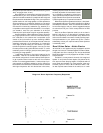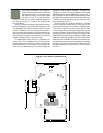
Now that your head is swimming, choose
your dimensions. The actual dimensions you
select based on a ratio such as those listed
below will determine the exact frequencies at
which the modes will develop. Jim Thiel, the
engineering brain behind Thiel speakers, calculated the fol-
lowing set of ratios:
2.5 by 1.6 by 1 2.18 by 1.6 by 1
1.39 by 1.14 by 1 1.54 by 1.14 by 1
2.33 by 1.6 by 1 1.9 by 1.4 by 1
1.9 by 1.3 by 1 2.1 by 1.6 by 1
2.5 by 1.5 by 1 1.59 by 1.26 by 1
I chose to build a room that measured 33’3” long by 22’9”
wide by 8’9” high. That’s 3.8 by 2.6 by 1. At the time, I thought
it was permissible to double any of the numbers (it isn’t). I
doubled two of them in the 1.9 by 1.3 by 1 ratio. Plug these
numbers into our Excel spreadsheet and the resulting plot of
modes looks something like Diagram 1.
Despite my mistake, the room ended up with a good
spread of modes (save for a pile-up at 50 Hz). Being somewhat
skewed myself, I chose not to build a perfectly rectangular
room (see Diagram 3, page 46) although I built it fairly rigidly
with studs that were on 12-inch centers and two layers of dry-
wall (the floor is concrete). I wanted an equipment room I
could walk into to change components and cables, and I want-
ed an opening from that room into the media room. I also
decided not to wall off the entrance to my office at the end of
the media room, leaving a floor-to-ceiling opening. Finally, I
have always suspected that rooms with bay windows or simi-
lar broken angles behind the speakers sound better. So I
framed in three-foot facets where the side walls meet the
front wall. If I ever get the chance to do it again, I would do it
a little differently – but that’s another story.
Deploying the Troops –
RPG Room Optimizer Software
Nothing is more important to good sound than where you
choose to place your speakers. Over the years there have been
numerous attempts at simple empirical formulae to help you
place the speakers. Perhaps the best known is the Rule of
Thirds (put the speakers at the one-third points away from the
side walls and back wall). The Rule of Thirds is derived from a
superficial understanding of modal room characteristics. This
approach, which seems to work with dipole loudspeakers, is
less than optimal for dynamic coil designs.
There is no predictable location that works optimally for
all speakers and all rooms; the variables are too numerous.
Indeed, finding the absolute best location for a certain speak-
er in a certain room is extraordinarily difficult (unlikely, but
not impossible). Now, though, there is a useful tool to credi-
bly attack the location issue: Room Optimizer software ($99 a
copy) from RPG Diffuser Systems, Inc. You quickly learn,
when using Room Optimizer, that what is optimal depends on
where you sit, on the geometry of the speakers, and their loca-
tion. Fortunately, Room Optimizer will consider all those vari-
ables for you.
Room Optimizer, in simple terms, does the math for you.
It combines a modal analysis with a Speaker Boundary Inter-
ference Response (SBIR) analysis based on the legendary
work of Roy Allison. It is the combination of these two
approaches that makes Room Optimizer unique and useful.
Balancing the modal and SBIR analysis, Room Optimizer
searches out locations within your room for your speakers
and your listening location that will meet a certain threshold
frequency uniformity. See Diagram Two for a graphic repre-
sentation of a solution that Room Optimizer found for the
Salons in my room.
I will eschew a detailed technical explanation of how
Room Optimizer works and concentrate more on how well it
works and its limitations. Know this about it: It will “do the
math” on many thousands of locations, relentlessly honing in
on the optimal location within parameters set by the user.
Room Optimizer randomly selects a starting spot within user-
defined boundaries. This random starting point influences
Room Optimizer’s search for the optimal location. Once it has
a starting spot, it works around that location gradually refin-
ing the search. Different starting locations lead to different
final solutions. For this reason, it can and usually does come
up with different solutions when fed identical parameters.
Thus, it is worthwhile to spend some time at the computer,
Diagram 1: Room Mode Calculator
by Allan Devantier


















